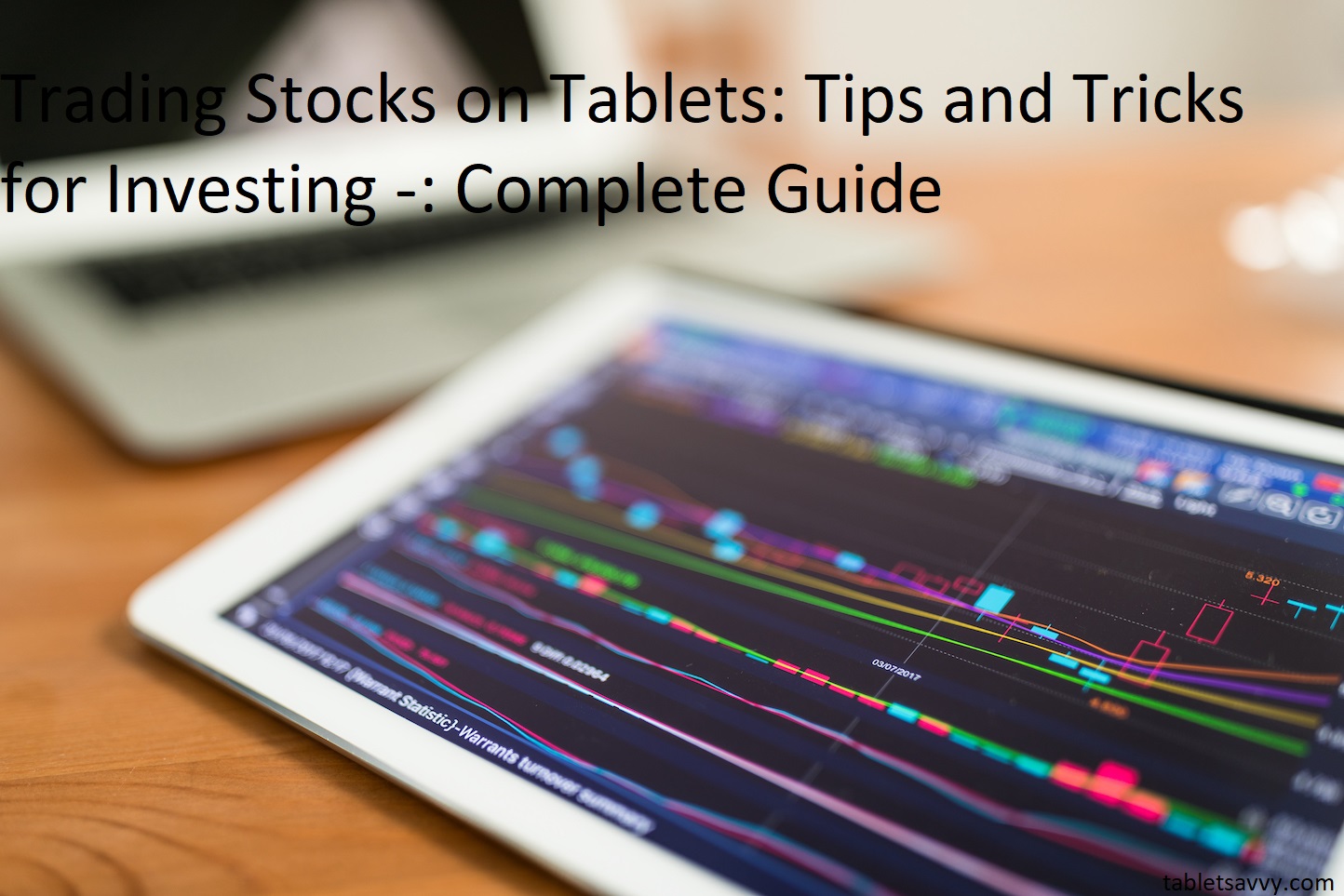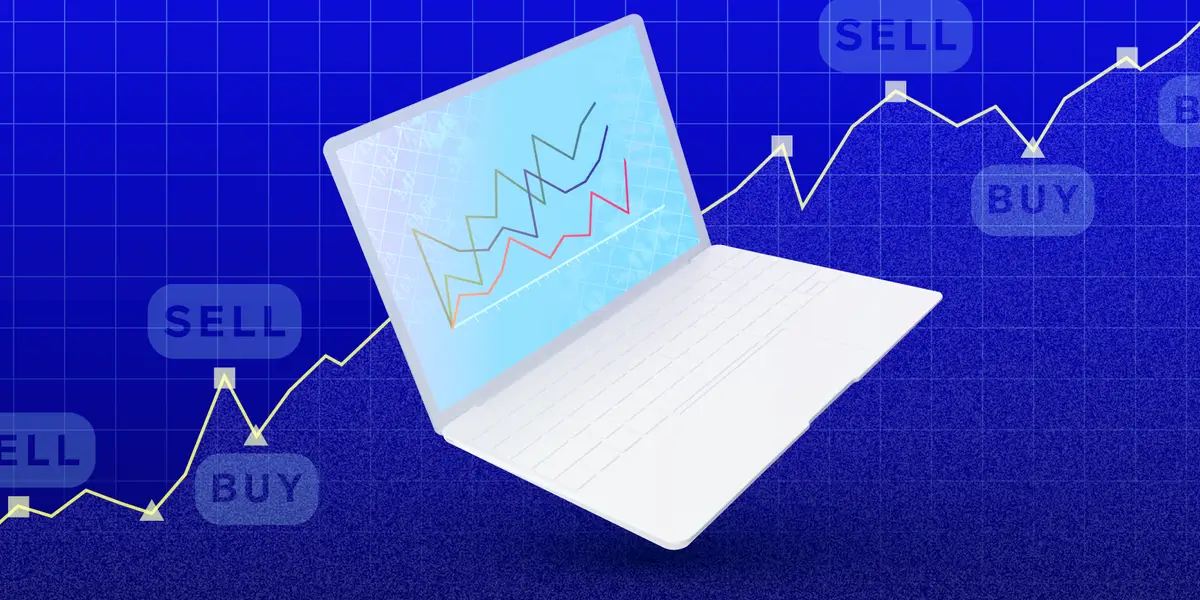Are you ready to take your stock trading to the next level? Why not do it from the convenience of a tablet?
Learn all the tips and tricks in this complete guide to investing on tablets. Make sure you have all the knowledge you need before making any big decisions.
Welcome to Trading Stocks on Tablets: Tips and Tricks for Investing, your complete guide to trading stocks on a tablet device. This handy guide will help you get started with investing in the stock market using a tablet device. We’ll walk you through the different steps involved in setting up and managing a portfolio, as well as offering tips and tricks on how to reduce risk, analyze stocks, and get the most out of your investment strategy. No matter if you’ve never invested before or you’re a seasoned stock trader looking to increase your chances of success, this comprehensive guide has something for everyone!
In this chapter we will introduce trading stocks on a tablet device, explain the different platforms available, discuss account fees/commissions, identify memberships/account types suitable for investors at different experience levels, and lastly provide an overview of trading process. Let’s get started!

Stock exchange data diagram on tablet computer
Explanation of the topic
Today’s landscape for the stock market is changing rapidly with the advent of technology. For many investors, this means having the ability to trade stocks from anywhere at any time, using their tablets. While tablets can offer some great advantages over traditional desktops, they also bring some unique challenges. This guide provides tips and tricks to help you make successful trades on your tablet!
By following these easy-to-follow steps, you’ll make sure that you get the most out of your tablet trading experience. First and foremost, ensure that you have a reliable wi-fi connection whenever possible. This will enable you to keep on top of live trades and receive immediate notifications when events occur in the market. Additionally, remember to keep your device up-to-date with the latest versions of both operating system software and third-party applications used for trading or researching stocks.
Next, use research tools available on your tablet to keep tabs on stocks before making a purchase or sale decision. Have multiple alert systems set up so that you don’t miss any changes in market conditions or important developments about a particular company whose stock is under consideration for immediate trade transactions. Understanding methods to assess current stock price performance in relationship to previous highs and lows can help determine if shares are valued appropriately for investment purchase or sale decisions.
Finally, use secure ecommerce platforms when completing transactions online from a tablet device like ApplePay or SquareCup – rather than directly from a broker account – as an added layer of protection against fraud or theft by providing end-to-end encryption between user data. With these simple tricks in mind during your Tablet trading activity, now nothing will stand in the way of success! Good luck and happy investing!
Importance of trading stocks on tablets
Trading stocks on tablets can be an advantageous way for investors to manage their portfolios, as it provides a much more convenient and efficient process when compared with other methods. By trading stocks on tablets, investors can easily view the stock market and check for updates on prices in real time or buy and sell stocks with the click of a button.
Tablets offer traders a wide array of features that make trading much easier than with traditional methods. For instance, traders have access to powerful charting capabilities that allow them view detailed stock charts and gain insight into market trends in order to identify profitable opportunities quickly and easily. In addition, some tablets come preloaded with mobile trading applications that enable stock traders to track market news, review current positions and execute trades instantly. This makes it easier for traders to keep up with the latest news and make informed decisions regarding their investments.
Furthermore, a tablet’s portability allows investors to manage their portfolios without being tied down to a desktop computer. As long as they have access to an internet connection, they can stay updated on their investments, no matter where they are. This eliminates the need for bulky laptops which may be difficult or uncomfortable to carry around all day; thus providing users more flexibility when it comes to managing their investments.
Overview of the article

This guide is aimed at both the experienced investor who wants to take advantage of the convenience of their tablet device, as well as the novice looking to get started in stock trading.
This article will provide a comprehensive overview of how to use a tablet to trade stocks. It will cover topics ranging from setting up and logging into your brokerage account, analyzing market trends and researching stocks, executing orders in real-time and tracking investments once they have been placed.
In-depth information on setting up portfolio management software, adjusting risk levels and monitoring news feeds related to investments will also be discussed. For those who are more technologically inclined, more advanced topics such as developing custom trading strategies and automated trading systems may also be covered depending on the platform used.
Finally, safety considerations such as encryption protocols used by brokers along with tips for protecting your digital identity while conducting trades online will be discussed as well.
Choosing the Right Tablet for Stock Trading
Choosing the right tablet for stock trading is important in order to ensure that you get the most out of your investments. With the multitude of options available, it’s important to consider what aspects matter most to you in terms of overall performance, display quality, and portability. To help inform your decision-making process, we have outlined some key aspects below when selecting a tablet that best suits your stock trading needs.
Display Quality: A tablet with good display quality is essential for evaluating charts and making sound financial decisions quickly. Look for displays with at least a 1080p resolution and wide viewing angles in order to determine nuances in graphs easily. For versatility during trading sessions on-the-go, a touchscreen display is ideal as it allows users to place orders by simply tapping on the screen.
Processing Power: When stock trading decisions need to be made quicky and accurately, having proper processing power is crucial. Investing in tablets powered by recent processors from trusted manufacturers like Qualcomm or Intel will help ensure that tasks are performed smoothly without any lags or hiccups in operation.
Portability: For traders who manage investments on the go regularly, portability is also an important factor when choosing a tablet device for their needs. Tablets come with varying sizes so it is worth considering how often you plan to take these devices along with you before purchasing one — larger screens may be necessary if you require more visual detail while smaller tablets offer greater convenience when travelling between different locations.
Screen size and resolution
When it comes to investing in stocks with a tablet, screen size and resolution become even more important. A large screen—9 inches or larger—is your best option for trading stocks on a tablet since it will enable you to view all of the information easily. You also should pay attention to the resolution as a lower resolution will make things difficult to read and interpret. Color accuracy is also important in order for you to get the full picture when making trading decisions.
Additionally, touch-screen input makes stock selection much easier and allows for smoother navigation when switching between different trading screens. Some tablets offer special features that can simplify the process of researching stocks or checking stock prices quickly. If a lot of research is necessary, additional tools like drawing tools may be necessary in order to effectively utilize data analysis methods on the tablet.
Processing power and storage

When it comes to processing power and storage, there are several things to consider when trading stocks on tablets. The majority of tablets that are available today come with a decent amount of RAM, which should be enough to open most stock trading apps and websites without experiencing significant lags or glitches. Lack of processing power can cause a sluggish experience when selecting stocks and moving through menus, which makes trading difficult. When considering tablet for investing in the stock market, aim for models with at least 2 GB of RAM and above.
In terms of storage capacity, it is important to know how much data will need to be stored on the device. Most apps do not take up too much space, but if you plan on storing videos or images related to your investments you’ll want to ensure that there is enough storage space available on the device before making your purchase. Selecting tablets with expandable memory options—such as microSD cards—will allow more flexibility when downloading data-heavy infographics or setting up background research materials for trades without taking up residential device storage space.
Battery life
It goes without saying that trading stocks can be a fairly power-intensive activity, and as such, you’ll want to ensure your tablet is up to the task. Battery life differs significantly depending on type and model, however, most mid range tablets today should last around 8-12 hours before needing a charge. Some tablets with larger than average batteries may last much longer depending on usage and settings.
To maximize battery life and optimize for trading stocks, consider disabling any extra features or applications running in the background. This will help extend battery life but if you rely heavily on battery power for trading stocks it may be worth investing in a tablet specifically designed for battery performance. Tablet cases can also provide additional layers of protection from bumps and bruises as well as more efficient charging capabilities.
Connectivity options
When trading stocks via a tablet, users should pay attention to the connectivity options available to them. Be sure that the tablet’s network connection is stable and has adequate bandwidth to keep up with the real-time markets. Connectivity can come in a number of forms, so be sure that your tablet will work with your current setup.
Wi-Fi is an increasingly popular connection solution for traders on their tablets due to its versatility and low cost. Many tablets come equipped with the option to switch between different access points depending on user location and preference, but be sure that these connections are secure before using them for trading.
Cellular networks are another option available for larger scale traders who need an extra layer of security and privacy while investing. Services like 4G LTE or 5G have been proven to provide faster speeds and greater reliability than Wi-Fi networks, though they require an additional data plan which can drive up costs.
When selecting a tablet for stock trading, it’s important to ensure that its featured connectivity options match your individual needs and preferences in order for it to prove useful in day-to-day trading scenarios.
Security features
When trading stocks on a tablet, it is essential to take care of security. Your trading station will contain financial information that is valuable and can attract criminals. Therefore, you should be aware of all the security features available to you and how they work.
Security features can range from biometric visuals such as fingerprint scans or facial recognition, to direct control and access of your device with password protection, remote wiping capabilities for both mobile devices and computers, encryption for data in transit and at rest, two-factor auth login when accessing exchanges, and tokenized payment processing.
Additionally, you will want to make sure your device is updated with the latest software so there are no vulnerabilities that criminals can exploit. You should also be sure to monitor your account activity regularly for anything suspicious or unauthorized movements and use anti-virus software like malwarebytes on PCs or similar options for devices such as tablets.
Setting Up Your Tablet for Stock Trading
Setting up your tablet for stock trading does not have to be difficult. With the right tips and tricks, you can set up your tablet to begin trading stocks in no time. To start, you will need to choose an app that best suits your needs. Whether you are looking for an actively managed portfolio or more of a do-it-yourself approach, there is an application out there for you! After you have decided on which app is best for you, it’s time to get started with setting up your tablet for stock trading. Here are some tips and tricks for putting together your tablet:
- Create a secure password: Before diving into the world of stock trading, make sure that your device is locked with a secure password and that two-factor authentication is enabled if possible. Taking security measures will ensure that malicious actors won’t be able to gain unwanted access to your device or accounts.
- Download the chosen stock market app: Now that your device has been secured by creating a unique password, it’s time to download the desired application. This can usually be done either by accessing the iTunes/Google Play store on your device or using an external download link given by brokerages or financial advisors. Once downloaded, read through all security prompts before logging in so that you know exactly what information will be shared between yourself and the app provider.
- Set up necessary accounts: Depending on whom you choose to open an account with–whether it be a traditional broker like TD Ameritrade or a digital alternative such as Robinhood–you will need create necessary user profiles before being able to begin making trades within their respective apps. Make sure any information given is accurate and stay mindful of any additional fees or steps needed during setup (i.e., completing Know Your Customer forms).
- Begin researching stocks and assets: The final step involves getting familiar with which assets exist in each market area so that informed decisions may be made prior to engaging in trade execution. Utilize resources provided online from independent research organizations (i.e., Morningstar) or make sure built-in charting tools are turned on within one’s chosen application so pricing movements can easily be monitored before pulling the trigger on a trade order!
Choosing a trading app

A trading app allows you to monitor and manage your portfolio from the convenience of a tablet. Depending on your needs, there are a wide range of available apps designed to facilitate trading. In order to determine the best app for you, there are several important considerations that you should bear in mind when making your selection.
Essentially, the app needs to provide you with all of the features that allow for managing and editing currency investments without overwhelming you with unnecessary extras. It is also important that it is intuitive and easy-to-use so that even those who do not have extensive technical knowledge can quickly get up to speed. Good customer support is also paramount since many users may require assistance navigating their chosen platform. All of these factors come together to ensure an optimal trading experience whether they are just starting out or seasoned veterans in the field.
Finally, it is worth noting some specific features which will make trading easier on a tablet such as consolidated watchlists with real-time notifications, customizable alerts, accurate charts which can be zoomed in or out or the ability to easily switch between portfolios and markets. Most good trading apps will have one or more of these features built into their interface – so keep this in mind when making your selection!
Creating an account
Creating an account is the first step to trading on a tablet. Before you open an account, consider these questions: What type of account do you want (e.g., retirement or investing)? How much money do you have to invest? And how much risk are you willing to take? Once you’ve answered these questions, then it’s time to create an account.
Depending on your goals, different accounts may be available for investing; such as a brokerage or online trading platform. Brokerages and online trading platforms are designed for different types of investors. Make sure that the one that you choose fits your investment style and risk level.
When signing up for a new account, there will be paperwork and forms that need to be filled out, including personal information such as social security number, birthdate and address. After signing up with a broker or online platform, then it will be necessary to fund the account with cash or other securities so that it can begin trading stocks on your tablet.
It’s important to keep in mind that deposits need to be fully cleared before they can start being used; which is typically 3-5 business days after being deposited into the accounts by either wire transfer or check/ACH deposits etc.. The broker/trading platform will tell you when funds are available for trading and investing when they are deposited in the US dollars currency.
Conclusion
The final step to become a successful trader using a tablet is to practice. Make sure to thoroughly research each stock before investing and remember, if something doesn’t feel right, it probably isn’t. Doing your research pays off but be prepared for anything. Finally, be patient and stay up-to-date with financial news as trends in the markets change quickly in response to events and industry changes.
These tips should help you become an effective trader on a tablet when executed properly. However, it is always important to use caution when trading stocks and invest only what you are willing to lose. With these key principles in mind, start trading today on your tablet – make the market work for you!
FAQ’s
Can trading be done on tablets?
Yes, trading can be done on tablets as long as you have a reliable internet connection and access to a trading platform that is compatible with your tablet’s operating system.
What is the most successful stock trading strategy?
There is no one-size-fits-all answer to this question as the most successful stock trading strategy can vary depending on a trader’s individual preferences, risk tolerance, and investment goals. Some popular strategies include value investing, growth investing, momentum investing, and dividend investing.
How to make $1000 rs per day trading?
Making $1000 rs per day trading is not a guaranteed outcome and can depend on a variety of factors such as market conditions, investment strategy, and trading skills. However, some tips for potentially increasing profits include setting realistic goals, managing risk effectively, and staying disciplined in your trading approach.
What is the trick to investing in stocks?
There is no one trick to investing in stocks, but some important factors to consider include doing thorough research on potential investments, diversifying your portfolio, and staying disciplined with your investment strategy.
What is the number 1 rule of stocks?
The number 1 rule of stocks is to always do your research and due diligence before investing. This includes analyzing a company’s financials, market trends, and any potential risks associated with the investment.
What are the four rules of successful stock investing?
The four rules of successful stock investing are to diversify your portfolio, invest for the long term, stay disciplined with your investment strategy, and avoid trying to time the market.
What are the 5 golden rules of investing?
The 5 golden rules of investing are to start early, invest regularly, diversify your portfolio, manage risk effectively, and stay disciplined with your investment strategy.
What is the 7 rule in stocks?
The 7 rule in stocks is a quick way to estimate how long it will take for your investment to double in value. The rule states that if you divide the number 72 by the annual rate of return, the result is the number of years it will take for your investment to double.
What is the 10 am rule in stocks?
The 10 am rule in stocks refers to waiting until 10 am before making any trades for the day. This allows time for the market to settle and for any early morning volatility to stabilize before making any investment decisions.
What is rule of 16 stocks?
The rule of 16 stocks is a quick way to estimate the fair value of a stock based on its price-to-earnings ratio. The rule states that if you subtract the current inflation rate from the P/E ratio, the result should be around 16.
See Also:
- Best tablet for photo editing 2023
- Best tablet for video editing 2023
- Best tablet for photoshop 2023
- Best tablet for roblox 2023
- Best tablet for procreate 2023


